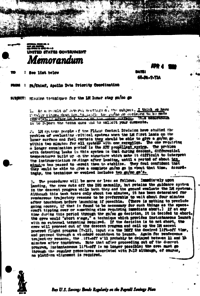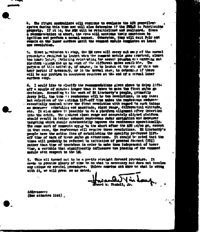Transcriber’s notes
There are two memorandums with the serial 68-PA-T-71A
See list belowAPR 4 196868-PA-T-71APA/Chief, Apollo Data Priority CoordinationMission techniques for the LM lunar stay go/no go
1. As a result of several meetings on the subject, I think we have finally pinned down how to handle the go/no go decision to be made immediately after LM landing on the lunar surface. This memorandum is to report the techniques and to solicit your comments.
2. LM systems people of the Flight Control Division have studied the problem of evaluating critical systems when the LM first lands on the lunar surface and feel certain they should be able to give a go/no go within two minutes for all systems with one exception. The one requiring a longer examination period is the APS propellent system. The problem with detecting leaks in this system is that during descent, differential temperatures build up on the structure which make it difficult to interpret the instrumentation readings after landing, until a period of about ten minutes has passed to permit them to stabilize. They feel confident that they would be able to give a complete go/no go in about that time. Accord- ingly, the technique we evolved includes two go/no go's.
3. The procedures will be more or less as follows. Immediately upon landing, the crew cuts off the DPS manually, but retains the guidance system in the descent program while both they and the ground evaluate the LM systems. Although this task takes only about two minutes, it has been determined for rendezvous trajectory reasons to be preferable to wait about four minutes after touchdown before launching if possible. (There is nothing to preclude going sooner, if that is found to be necessary for such things as the space- craft tipping over or something else requiring immediate abort.) If at any time during this period through the go/no go decision, it is decided to abort, the crew would “abort stage,” a technique which provides instantaneous launch with no external targeting required. If the decision is to not abort, the crew will proceed out of the descent program and call up the LM ascent powered flight program (P-12), input via the DSKY the desired lift-off time, and proceed through a standard countdown to launch. Again for rendezvous trajectory reasons, the lift-off will probably be delayed between 11 and 14 minutes after touchdown. Note that after proceeding out of the descent program, instantaneous lift-off is no longer possible; the crew must go through the regular procedures associated with P-12 although, of course, no platform alignment is required.
4. The flight controllers will continue to evaluate the APS propellant system during this time and will also determine if the PGNCS is functioning properly. If it is, the AGS will be reinitialized and realigned. Given a recommendation to abort, the crew will continue their countdown to ignition and perform a normal ascent. Otherwise, they will exit P-12 and remain on the lunar surface until the command module completed at least one revolution.
5. Given permission to stay, the LM crew will carry out many of the normal procedures required to launch when the command module goes overhead, almost two hours later, including retargeting the ascent program and carrying out platform alignments using each of the different modes available. The purpose of this activity, of course, is to launch at the end of this two hour period if necessary, or in the normal case, to determine if there will be any problem in countdown required at the end of a normal lunar surface stay.
6. I would like to clarify the recommendations given above to delay lift- off a couple of minutes longer than it takes to make the first go/no go decision. According to the work of Ed Lineberry's people, primarily Jerry Bell, the time to rendezvous will be two revolutions, in any case; but selection of the optimum lift-off time makes the rendezvous sequence essentially nominal after the first revolution with regard to such things as maneuver scheduling and magnitude, slant range, differential altitude, etc. It also makes it possible to do a platform alignment after insertion into the orbit. The reduced slant range and accurately aligned platform should result in better onboard rendezvous radar navigation and maneuver targeting which should substantially improve the rendezvous operationally. The same sort of comments apply to the abort after the APS go/no go, except in that case, the rendezvous will require three revolutions. Ed Lineberry's people have the action item of establishing the specific preferred lift- off time of each of these go/no go situations. It should be noted that the times will probably be referred to initiation of powered descent (PDI) rather than time of touchdown in order to make them independent of hover time, a variable that significantly influences the phasing of the command module with respect to the LM.
7. This all turned out to be a pretty straight forward procedure. It seems to provide plenty of time to do what is necessary and does not involve any unique or special procedures. Unless someone can show us what is wrong with it, we will press on as noted.
- Feb 11, 1969 – G Lunar Surface Phase Mission Techniques (4.5σ)
- Apr 05, 1968 – Mission “E” Rendezvous Data Priority meetings (4.2σ)
- Mar 18, 1968 – Lunar rendezvous abort summary (3.5σ)
- Apr 10, 1968 – “Any time” LM lift off is an unnecessary constraint (3.6σ)


